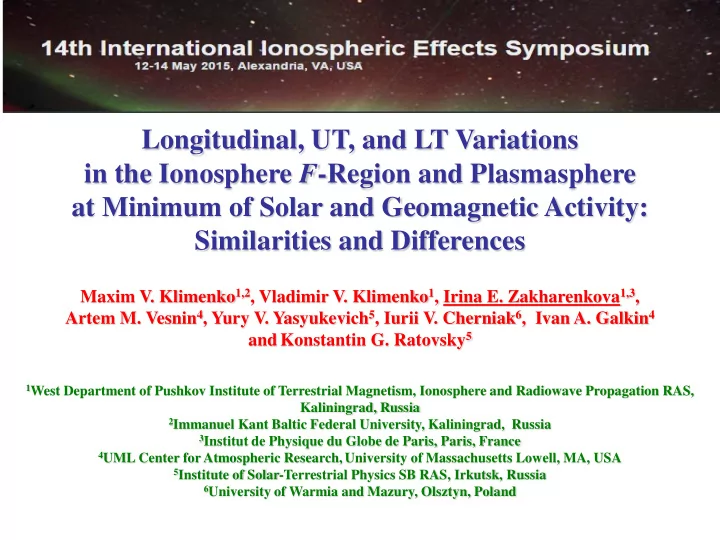

Longitudinal, UT, and LT Variations in the Ionosphere F -Region and Plasmasphere at Minimum of Solar and Geomagnetic Activity: Similarities and Differences Maxim V. Klimenko 1,2 , Vladimir V. Klimenko 1 , Irina E. Zakharenkova 1,3 , Artem M. Vesnin 4 , Yury V. Yasyukevich 5 , Iurii V. Cherniak 6 , Ivan A. Galkin 4 and Konstantin G. Ratovsky 5 1 West Department of Pushkov Institute of Terrestrial Magnetism, Ionosphere and Radiowave Propagation RAS, Kaliningrad, Russia 2 Immanuel Kant Baltic Federal University, Kaliningrad, Russia 3 Institut de Physique du Globe de Paris, Paris, France 4 UML Center for Atmospheric Research, University of Massachusetts Lowell, MA, USA 5 Institute of Solar-Terrestrial Physics SB RAS, Irkutsk, Russia 6 University of Warmia and Mazury, Olsztyn, Poland
Theoretical Model - GSM TIP Global Self-consistent Model Thermospheric parameters: T n , O 2 , N 2 , O, NO, N( 4 S),N( 2 D) of the Thermosphere, Ionosphere densities; vector of velocities; and Protonosphere (GSM TIP) was (from 80 km to 500 km) developed in West Department of IZMIRAN. The model GSM TIP Ionospheric/plasmaspheric parameters: was described in details in O + , H + , Mol + densities; Namgaladze et al., 1988. T i and T e ; Vectors of ion velocities (from 80 km to 15 Earth radii) Case study: 22 December 2009 Electric field: The model is added by the new block of electric field calculation Klimenko et al ., 2006, 2007.
Empirical Model – IRTAM IRTAM - IRI-based Real-Time Assimilative Mapping (IRTAM) [ Galkin et al ., 2012] International Reference Ionosphere model + Global Ionosphere Radio Observatory (GIRO) measurements Image credit: http://giro.uml.edu/IRTAM/
Observations 1) Global Ionospheric Maps (GIM) of TEC 12_00 IGS final product 80 60 40 20 0 -20 -40 -60 -80 -180 -120 -60 0 60 120 180 2) Electron density profiles derived from FORMOSAT-3/COSMIC RO 800 DATE: 2009-03-19 TIME: 04.08 UT 700 600 Altitude (km) 500 400 300 200 cosmic 100 ionosonde 0 0 0.5 1 1.5 2 Electron density (105 el/cm3) TACC
LT variation Model Observations - Main reason of LT variation is the solar ionization - Qualitative agreement between model simulations and observations - GSM TIP underestimates foF2 and TEC due to overestimation in neutral density
Longitudinal variation Model IRTAM Observations - Main reason of UT and longitudinal variations is discrepancy between geographic and geomagnetic axis - Agreement between IRTAM foF2 and GPS TEC -The qualitative differences with data possibly relate to the insufficient data coverage in the SH
UT variation Model IRTAM Observations - Main reason of UT and longitudinal variations is discrepancy between geographic and geomagnetic axis - High-latitude maximum is observed near 06 UT, low-latitude one – 18 UT
Results demonstrate that - longitudinal, UT and LT variations of foF2 and TEC are of the same order except for equatorial region; - In equatorial ionosphere foF2 and TEC are the largest around local noon and do not exceed values at different locations by the order of magnitude; - Morphological features of foF2 and TEC are in agreement with each other; - We conclude that the ionosphere is a main source of TEC variations under geomagnetic quiet condition. This is reasonable as the plasmasphere, another contributor to TEC , should not vary much under geomagnetically quiet conditions.
Example of longitudinal variation: WSA
Model IRTAM Night Time DayTime
Model Observations
CONCLUSIONS • We considered the morphological features of longitudinal variations of electron density in the ionosphere-protonosphere system. • We reveal the Weddell Sea Anomaly occurrence in the protonospheric electron content. This study was supported by grants of the RF President MK-4866.2014.5 and RFBR № 14-05-00578.
Recommend
More recommend